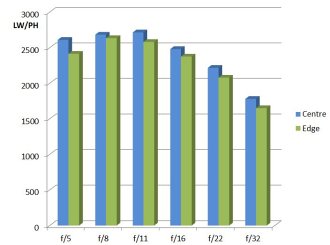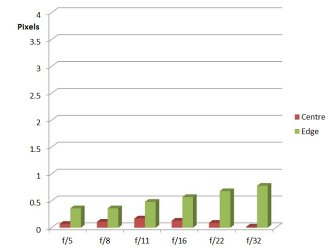Tamron SP 150-600mm f/5-6.3 Di VC USD G2 Review
Tamron SP 150-600mm f/5-6.3 Di VC USD G2 Performance
Central sharpness at 150mm is excellent from the start, and this holds from f/5 through to f/16. At f/22 and f/32 sharpness is still very good. The edges are also excellent from f/5 to f/16, very good at f/22 and still holding to good levels at f/32.
How to read our charts
The blue column represents readings from the centre of the picture frame at the various apertures and the green is from the edges.The scale on the left side is an indication of actual image resolution as LW/PH and is described in detail above. The taller the column, the better the lens performance.
For this review, the lens was tested on a Canon EOS 6D using Imatest.
How to read our charts
Chromatic aberration is the lens' inability to focus on the sensor or film all colours of visible light at the same point. Severe chromatic aberration gives a noticeable fringing or a halo effect around sharp edges within the picture. It can be cured in software.Apochromatic lenses have special lens elements (aspheric, extra-low dispersion etc) to minimize the problem, hence they usually cost more.
For this review, the lens was tested on a Canon EOS 6D using Imatest.
At 300mm, central sharpness is very good at the widest aperture of f/6.3, excellent from f/8 to f/16 and very good at f/22. It is still good at f/32, but drops to only fair at the minimum aperture of f/40. The edges start off very good at f/6.3 and f/8, are excellent at f/11 and f/16, very good at f/22. f/32 still sees good sharpness, but f/40 is only fair.
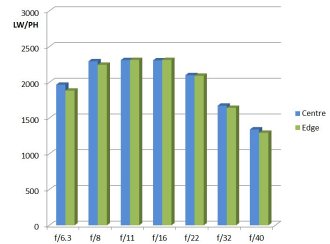 |
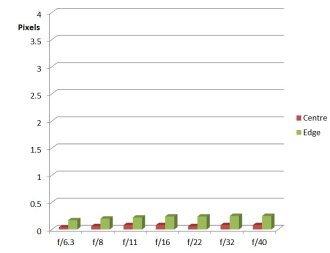 |
| MTF@300mm | CA@300mm |
At 450mm, the centre shows excellent sharpness from f/6.3 to f/11, very good from f/16 to f/22, still good at f/32 and only dropping to just fair at f/40. The edges show very good sharpness at f/6.3, excellent at f/8 and f/11, and again a similar pattern as the centre. Very good sharpness holds to f/16 and f/22 and this drops to good at f/32 and fair at f/40.
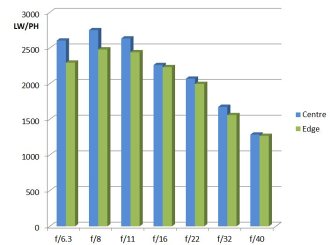 |
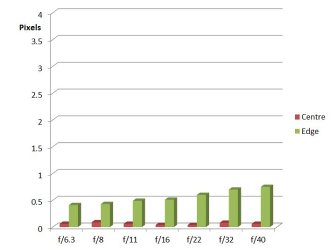 |
| MTF@450mm | CA@450mm |
Sharpness centrally is still holding well at 600mm, being very good at f/6.3 and f/8, excellent at f/11, very good at f/16 and f/22 and good at f/32. F/40 is just fair. The edges at 600mm start off fair at f/6.3, becoming good between f/8 and f/22, and dropping again to fair at f/32 and f/40. Although the performance has dropped off at 600mm, the centre stills hold up well and make the lens very suitable for a good range of wildlife and sports photography. It is also worth noting that at the best apertures the image quality is very even, edge to edge.
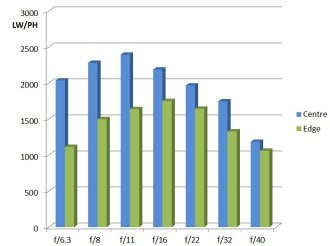 |
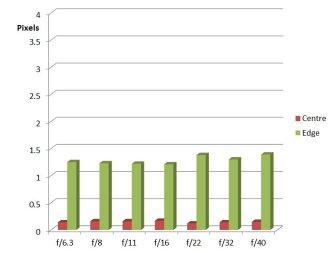 |
| MTF@600mm | CA@600mm |
Correction for CA (Chromatic Aberration) is of a high order. Throughout the zoom range, the centre shows almost complete correction, with very low measured figures. The edges do have a small amount of CA that becomes more obvious as we zoom in, but even at 600mm the degree of correction is very satisfactory. Any residual CA can be corrected in software if desired.
Flare control is also excellent. It is quite difficult to induce flare, not impossible, but for even demanding shots it is not really a problem.
Distortion is also well held across the zoom range, to levels that are really very moderate. This is especially noteworthy, especially with such a long lens. Pincushion distortion measures at +1.43% (150mm), +1.45% (300mm), +1.47% (450mm) and +1.47% (600mm). In any event, software correction is easily possible.
With such a long lens, the out of focus areas are always likely to look good and this new lens is no exception. The bokeh is pleasant and, at wider apertures quite sublime, throwing isolated subjects forwards into sharp relief. The generally excellent performance at wider apertures adds up to a strong overall quality in the images.
Value For Money
The Tamron 150-600mm f/5-6.3 Di VC USD G2 lens is priced at £1349, somewhat higher than the first version, which is still available at £829 (1951g). Nonetheless, the new version is better all round in performance so the extra may well be justified. Alternatively, the previous lens might well be considered a bargain.
Sigma offer an alternative in the 150-600mm f/5-6.3 Contemporary OS HSM lens (£739, 1930g) and the more durable Sport version at £1199 (2860g).
Although not quite the same range, Canon users have the Canon EF 100-400mm f/4-5.6L IS II USM lens at £1799 (1640g). Nikon users have the Nikon AF-S 200-500mm f/5.6E ED VR at £1179 (2300g).
Just to complete the perspective across DSLR marques, Pentax users have no version of this lens, but the HD Pentax-D FA 150-450mm f/4.5-5.6 ED DC AW costs £1699 (2000g). Sony users don't currently have anything similar. For more options have a look at the Top 5 Best Tamron lenses.
Add your message
Please login here or if you've not registered, you can register here. Registering is safe, quick and free.
photodo Stats
428 MTF tests
74 in-depth photodo reviews
100+ users join each day
Help the lens community by reviewing or rating a lens today via our lens search
Latest Lens Reviews
- Chinon 28mm f/2.8 Vintage Lens Review
- Canon EF 70-200mm f/4L IS II USM Lens Review
- Samyang AF 85mm f/1.4 EF Review
- Sigma 70mm f/2.8 DG Macro Art Review
- Samyang AF 24mm f/2.8 FE Review
- Meike 50mm f/1.7 Review
- Tamron 70-210mm f/4 Di VC USD Review
- Lensbaby Burnside 35mm f/2.8 Review
- Asahi Super Takumar 50mm f/1.4 Review
- Asahi Super-Multi-Coated Takumar 135mm f/3.5 Review
